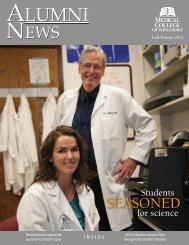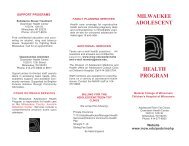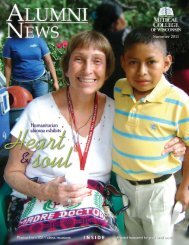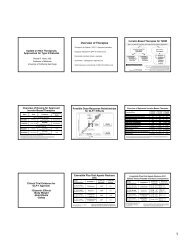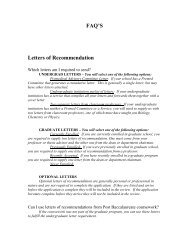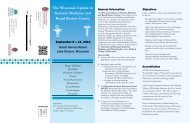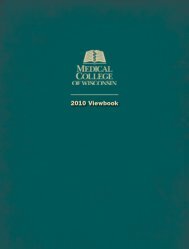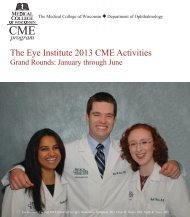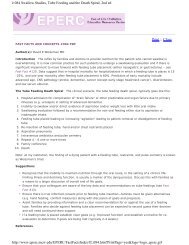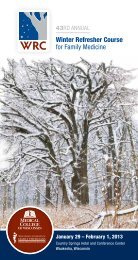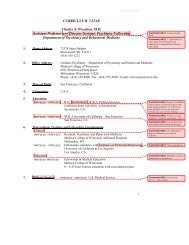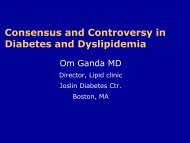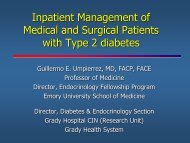Evaluation and Treatment of Diabetic Neuroarthropathy - Medical ...
Evaluation and Treatment of Diabetic Neuroarthropathy - Medical ...
Evaluation and Treatment of Diabetic Neuroarthropathy - Medical ...
You also want an ePaper? Increase the reach of your titles
YUMPU automatically turns print PDFs into web optimized ePapers that Google loves.
<strong>Evaluation</strong> & <strong>Treatment</strong> <strong>of</strong><br />
<strong>Diabetic</strong> <strong>Neuroarthropathy</strong><br />
Richard M Marks, M.D., FACS<br />
Pr<strong>of</strong>essor & Director,<br />
Division <strong>of</strong> Foot & Ankle Surgery<br />
<strong>Medical</strong> College <strong>of</strong> Wisconsin
<strong>Evaluation</strong> & <strong>Treatment</strong> <strong>of</strong><br />
<strong>Diabetic</strong> <strong>Neuroarthropathy</strong><br />
Richard M Marks, M.D., FACS<br />
I have no pr<strong>of</strong>essional conflicts<br />
associated with this lecture<br />
consultant: Biomet, Tornier
Objectives<br />
• discuss the musculoskeletal care <strong>of</strong><br />
patients with diabetes mellitus<br />
• foot <strong>and</strong> ankle issues<br />
neuropathy<br />
ulceration<br />
Charcot neuroarthropathy<br />
amputation
Objectives<br />
• epidemiology<br />
• etiology<br />
• diagnosis<br />
• treatment<br />
medical<br />
surgical
Diabetes; the “giving” disease<br />
• endocrinology<br />
• nephrology<br />
• cardiology<br />
• neurology<br />
• ophthalmology<br />
• P M & R<br />
• physical therapists<br />
• orthopaedic surgery<br />
• vascular surgery<br />
• plastic surgery<br />
• transplant surgery<br />
• wound care<br />
• dieticians<br />
• orthotists, prosthetists
Diabetes mellitus<br />
Epidemiology<br />
25,800,000 people (8.3% population)<br />
diagnosed: 18,800,000<br />
undiagnosed: 7,000,000<br />
“it sees you, but you may not see it…”<br />
National Diabetes Fact Sheet<br />
http://www.cdc.gov/diabetes
Diabetes mellitus<br />
Epidemiology<br />
>65 y.o.: 10,900,000 (26.9%) have D.M.<br />
„05-‟08: fasting glucose/HbA1c levels<br />
35% > 20 y.o. have prediabetes<br />
50% > 65 y.o. have prediabetes<br />
National Diabetes Fact Sheet<br />
http://www.cdc.gov/diabetes
Neuropathy<br />
Epidemiology<br />
60 – 70% <strong>of</strong> diabetics<br />
National Diabetes Fact Sheet<br />
http://www.cdc.gov/diabetes<br />
differential:<br />
alcohol cord trauma/tumor idiopathic<br />
syringomyelia myelomeningocoele<br />
cerebral palsy leprosy syphilis
Neuropathy<br />
Epidemiology<br />
associated with:<br />
age, duration<br />
poor glucose control<br />
no correlation with type I/II, sex<br />
Diabetes control research grp<br />
Ann Int Med 122: 1995
Etiology<br />
Neuropathy<br />
symmetrical > asymmetrical<br />
sensory fibers > autonomics<br />
distally accentuated loss <strong>of</strong> myelinated <strong>and</strong><br />
unmyelinated fibers<br />
electrophys. studies indicate axonal loss<br />
sensory <strong>and</strong>/or motor<br />
Dyck, et al:<br />
Neurology 43: 1993
Neuropathy<br />
metabolic contribution:<br />
hyperglycemia results in: accumulation <strong>of</strong><br />
sorbitol; ↓ myo-inositol; conduction block<br />
<strong>of</strong> myelinated axons<br />
vascular contribution:<br />
extraneural A-V shunting; hypoxia<br />
narrowed capillary/arteriolar lumens<br />
poor regulation <strong>of</strong> microcirculation
Neuropathy<br />
Sensory dysfunction:<br />
distal → proximal; stocking-glove pattern<br />
large fiber: ↓ light touch, proprioception<br />
small fiber: ↓ pain, temp. perception<br />
paresthesias; possibly due to spontaneous<br />
depolarization <strong>of</strong> regenerating nerve<br />
fibers
Neuropathy<br />
Autonomic dysfunction:<br />
arteriovenous shunting<br />
loss <strong>of</strong> skin temperature regulation<br />
perspiration loss<br />
nonpliable skin<br />
hypertrophic callosities
Neuropathy<br />
Motor dysfunction:<br />
demyelinization causes conduction deficits<br />
more commonly distal<br />
results in intrinsic musculature dysfunction<br />
clawing <strong>of</strong> toes<br />
metatarsal head depression<br />
plantar pressure concentration
Neuropathy<br />
Immune dysfunction:<br />
malnutrition, hyperglycemia, hypoxia results<br />
in inefficient anaerobic metabolism<br />
acidity, hypertonicity, edema<br />
altered PMN chemotaxis
Neuropathy<br />
Diagnosis:<br />
Semmes-Weinstein mon<strong>of</strong>ilaments<br />
5.07 (10 gm.) size<br />
100% sensitive, 75% specific<br />
biothesiometer (vibratory stimulus)<br />
79% sensitive, 93% specific<br />
Kumar, et al<br />
Diab Res, Clin Pract 13: 1991
Neuropathy treatment<br />
• maximize glucose control<br />
intensive tx. ↓ neuropathy 64%<br />
• oral medication for painful neuropathy*<br />
gabapentin, cymbalta, lyrica<br />
• compounded nerve creams<br />
Diabetes control research grp<br />
Ann Int Med 122: 1995
Neuropathy treatment<br />
Guidelines for diabetic foot care<br />
foot-specific patient education<br />
skin <strong>and</strong> nail care<br />
therapeutic footwear<br />
Medicare therapeutic foot bill; 1993<br />
FAI 20: 1999
<strong>Diabetic</strong> foot ulcer<br />
Epidemiology<br />
15% <strong>of</strong> diabetics (3-4% <strong>of</strong> pop.)<br />
precede 85% <strong>of</strong> L.E.A. in diabetics<br />
National Diabetes Fact Sheet<br />
http://www.cdc.gov/diabetes
<strong>Diabetic</strong> foot ulcer<br />
Epidemiology<br />
35% Charcot have ulcer @ 1 st presentation<br />
Game, et al:<br />
Diabetologia 55: 2012<br />
ulcer @ 1 st presentation → 28% amputation<br />
Dalla Paola,Fagia:<br />
Curr Diab Rev 2: 2006
Ulcer formation<br />
pressure + neuropathy
intrinsic imbalance → clawtoes;<br />
(+) neuropathy ……<br />
→ ulcers<br />
Ulcer formation
depth<br />
Ulcer classification<br />
0: “at risk”, intact skin<br />
1: superficial<br />
2: deep; tendon/joint exposed<br />
3: extensive; bone exposed *<br />
ischemic<br />
a: nml<br />
b: ischemia<br />
c: partial gangrene<br />
d. nasty gangrene
Ulcer treatment<br />
• structural factors WB x-rays<br />
• sensation<br />
• circulation<br />
• infection<br />
• healing potential labs<br />
mon<strong>of</strong>ilaments<br />
ABIs with toe pressures<br />
labs, imaging
Mechanical, structural factors<br />
• clawing <strong>of</strong> toes<br />
plantar pressure, dorsal impingement<br />
• unstable Charcot foot<br />
• stable foot with bony prominence<br />
• requires weight-bearing films !!
Ulcer treatment<br />
• neurogenic vs. vasculogenic<br />
neurogenic ulcers might heal<br />
vasculogenic ulcers won‟t heal<br />
• must distinguish between the 2<br />
(or combination)
Sensation<br />
Mon<strong>of</strong>ilament testing<br />
5.07 (10 gm) threshold<br />
protective sensation
Circulation<br />
ABIs with toe pressures<br />
vessel compliance affected by small vessel<br />
calcification; toe pressures necessary<br />
ABI > .45 required for amp. healing*<br />
t.p. > 45 mm Hg for amputation<br />
t.p. > 60 mm Hg for ulcer healing<br />
• if not, → Vascular consult
Circulation<br />
Waveform characteristics
Circulation<br />
• TcPO 2<br />
• skin heated to 44°C, 10 min.s<br />
• tests autonomic response<br />
• adversely affected by edema, cellulitis<br />
1-19 mm Hg 50%<br />
20-29 mm Hg 75%<br />
>30 mm Hg 92%
Infection<br />
• screening labs<br />
CBC, ESR,CRP<br />
• advanced imaging<br />
• if concern for osteomyelitis, abscess<br />
triple phase (+) tagged WBC (Indium)<br />
MRI (+) gadolinium, fat suppression
Infection
Infection
Infection<br />
Probe to bone = osteo.
Healing potential<br />
Screening labs<br />
total protein > 6.2 g/dL<br />
albumin > 3.5 g/dL<br />
total lymphocyte count > 1,500/mm 3
Ulcer treatment<br />
• <strong>of</strong>f-loading<br />
• protection<br />
• correction<br />
crutches, walker, wheelchair<br />
relief shoe, boot, TCC<br />
orthotic, brace, CROW<br />
exostectomy, reconstruction
Off-loading<br />
• pressure prevents ulcer healing !!<br />
• location <strong>of</strong> ulcer determines type <strong>of</strong><br />
immobilization<br />
relief shoe with plastazote lining<br />
boot brace with plastazote lining<br />
total contact cast<br />
• assist device to help unweight
Total contact cast<br />
• edema control device<br />
• vertical forces distributed over sole<br />
• shear forces reduced<br />
• labor-intensive<br />
• prevents local wound care<br />
Laing, et al: JBJS 74: 1992
Total contact cast
TCC results<br />
• 28/36 (78%) heal in 6.3 weeks<br />
• 16/28 (57%) re-ulcerated<br />
Laing, et al; JBJS 74b: 1991<br />
• 16/22 (73%) heal in 5.8 weeks<br />
• 49% ulcers recur<br />
Helm; Arch PMR 65: 1984<br />
Saltzman, et al; CORR 435: 2005
Protection
Correction<br />
exostectomy<br />
stable deformity<br />
over-resection can create collapse<br />
reconstruction<br />
unstable deformity<br />
chronic Charcot
Exostectomy
Exostectomy
Exostectomy
Exostectomy<br />
• #41 Charcot pt.s followed > 8 yr.<br />
2/3 ulcerated → 50% required surgery<br />
exostectomy successful: 62%<br />
Pakarinen, et al; F.Ankle Surg 15: 2009<br />
• exostectomy: 74 – 91% healing<br />
lateral exostectomy → 2/3 recur<br />
Lowery, et al; FAI 33: 2012
Reconstruction
Reconstruction
<strong>Neuroarthropathy</strong><br />
• Jean-Martin Charcot (1868)<br />
1 st described neuropathic changes in a<br />
syphilitic patient; disease <strong>of</strong> “trophic<br />
centers” <strong>of</strong> anterior horn cells<br />
• Jordan (1936)<br />
1 st described diabetic neuropathy<br />
• Bailey (1942)<br />
tarsal destruction in 14 uncontrolled DM
<strong>Neuroarthropathy</strong><br />
• bony destruction in neuropathic patients<br />
• associated instability<br />
• ulceration 2° to bony prominence<br />
• confused with:<br />
cellulitis<br />
osteomyelitis<br />
acute fracture
<strong>Neuroarthropathy</strong><br />
Typical scenario<br />
initial dx. <strong>of</strong> cellulitis/osteomyelitis<br />
“confirmatory” bone scan<br />
intravenous antibiotics<br />
bone biopsy request<br />
no x-rays obtained
<strong>Neuroarthropathy</strong><br />
40 y.o.; IDDM<br />
3 wk. h/o red, swelling<br />
no constitutional sx.<br />
no ulcer<br />
abx. not improving<br />
no immobilization
<strong>Neuroarthropathy</strong><br />
• “no ulcer – no osteo”<br />
• neuropathic swelling ↓↓ with elevation
<strong>Neuroarthropathy</strong><br />
Epidemiology<br />
1.4 – 2.5% <strong>of</strong> all diabetics<br />
25% delay in diagnosis<br />
35% Charcot with ulcer at presentation<br />
30% contralateral within 2 yr.<br />
median time resolution: 9 months
<strong>Neuroarthropathy</strong><br />
“at-risk” factors<br />
retinopathy<br />
nephropathy<br />
previous ulceration<br />
↓ 5.07 mon<strong>of</strong>ilament<br />
Foltz, et al:<br />
J Foot Ankle Surg 43: 2004
Etiology<br />
Neurotraumatic theory<br />
↓ proprioceptive reflexes via post. roots<br />
repetitive trauma to insensitive joints<br />
results in fracture <strong>and</strong>/or dislocation<br />
Volkman, Virchow<br />
Johnson; JBJS 49a: 1967
Etiology<br />
Neurovascular theory<br />
neurally initiated vascular reflex<br />
“autosypathectomy”<br />
blood flow, osteoclastic bone resorption<br />
initial atrophic, destructive changes<br />
secondary reparative phase<br />
Charcot; 1868<br />
Brower, Allman; Radiology 139: 1981
Classification<br />
Eichenholtz<br />
stage I: acute, inflammatory<br />
stage II: reparative, unstable<br />
stage III: consolidated, stable<br />
stage “0”: neuropathic foot “at risk”<br />
Schon, Marks;<br />
Orth Clinics N.A. 26:1995
stage I Charcot<br />
• x-ray: fragmentation, subluxation<br />
• clinical: red, warm, swollen foot<br />
• no ulcer, no osteo<br />
• elevation improves clinical signs
stage II Charcot<br />
• x-ray: coalescence <strong>of</strong> bone<br />
• clinical: decreased warmth, swelling<br />
• fluctuation <strong>of</strong> clinical signs with<br />
increased activity<br />
• joints not stable
stage III Charcot<br />
• x-ray: reconstitution <strong>of</strong> bone<br />
• clinical: resolution <strong>of</strong> redness, warmth,<br />
swelling<br />
• joints stable on exam
stage “0” Charcot<br />
• x-ray: normal<br />
• clinical: history <strong>of</strong> trauma<br />
• +/- swelling<br />
• any diabetic, neuropathic patient is<br />
considered “at-risk” with any history <strong>of</strong><br />
trauma, even in light <strong>of</strong> a normal xray<br />
<strong>and</strong> exam
<strong>Neuroarthropathy</strong><br />
<strong>Treatment</strong> goals<br />
create a mechanically stable foot<br />
plantigrade; can accommodate a shoe<br />
<strong>and</strong>/or a brace<br />
prevent bony prominence<br />
that will ulcerate
<strong>Treatment</strong> considerations<br />
• stage <strong>of</strong> Charcot<br />
• deformity +/- instability<br />
• ulceration +/- deep infection<br />
• healing potential<br />
vascular status, nutrition, tobacco
Charcot acute treatment<br />
• strict immobilization<br />
TCC<br />
boot brace (no deformity)<br />
• strict <strong>of</strong>f-weighting<br />
• elevation<br />
• patient education
Charcot acute treatment<br />
• change initial cast @ 1 week<br />
• successive casts based on swelling<br />
• serial radiographs<br />
• months to resolve<br />
• role <strong>of</strong> bisphosphonates ?<br />
inhibit osteoclasts, ↓ skin temp<br />
• intranasal calcitonin + Ca. ?
Stage II treatment<br />
• protected weightbearing<br />
TCC, boot<br />
• slow, gradual increase<br />
10-25% over 4 weeks, → x-ray<br />
25-50% over 4 weeks, → x-ray<br />
50-100% over 6-8 weeks, → x-ray
Stage III treatment<br />
• wean into protective orthotic/brace,<br />
shoewear<br />
• foot must be able to accommodate<br />
shoes, orthotics, braces<br />
• evaluate any bony prominence
Surgical indications<br />
• gross instability<br />
• cannot maintain a plantigrade position<br />
with a shoe/brace<br />
• irreducible fracture-dislocation<br />
• recurrent ulceration<br />
• reconstruction in stage I (acute) only for<br />
dislocation or threatened skin
Amputation<br />
Epidemiology<br />
#1 cause nontraumatic amputations<br />
> 60% in diabetics<br />
2006: 65,700 L.E.A. in diabetics<br />
2 yr. mortality<br />
BKA: 36%<br />
AKA: > 50%<br />
National Diabetes Fact Sheet<br />
http://www.cdc.gov/diabetes
Amputation<br />
Epidemiology<br />
20X higher amputation rate vs. gen.l pop.<br />
Moss, et al:<br />
Diabetes Care 22: 1999<br />
26% require an additional amputation<br />
1/3 die within 1 yr.<br />
Dillingham, et al:<br />
Arch PMR 86: 2005
<strong>Diabetic</strong> salvage failure<br />
• poor control<br />
• poor compliance<br />
• poor physician recognition<br />
• lack <strong>of</strong> coordinated approach
Limb salvage vs. amputation<br />
• will salvage outperform a prosthesis ?<br />
• reasonable outcome expectation ?<br />
• what are the costs ?<br />
• what are the risks ?
Conclusions<br />
Neuropathy treatment<br />
mon<strong>of</strong>ilament testing<br />
maximize glucose control<br />
protective orthotics<br />
protective shoewear<br />
education
Conclusions<br />
Ulcer treatment<br />
pressure (+) neuropathy = ulcer<br />
neurogenic vs. vasculogenic<br />
ABIs + toe pressures<br />
vascular consult for suspected insuff.<br />
nutritional status ?
Conclusions<br />
Ulcer treatment<br />
infectious evaluation<br />
triple phase (+) tagged WBC<br />
MRI for suspected abscess<br />
protection !!<br />
<strong>of</strong>fweight, followed by orthotics<br />
exostectomy vs. reconstruction
Conclusions<br />
Charcot treatment<br />
redness, warmth, swelling = Charcot<br />
no ulcer, no osteo.<br />
weightbearing x-rays<br />
<strong>of</strong>fweight<br />
elevate<br />
evaluate
Conclusions<br />
Charcot treatment<br />
recognize stages<br />
recognize at-risk patients<br />
acute surgery for dislocation, skin at risk<br />
reconstruction for chronic instability,<br />
nonbraceble deformity<br />
protective orthotics, braces shoewear<br />
education
Vascular<br />
Endocrine<br />
Orthopedics<br />
Wound care<br />
Limb preservation in the<br />
diabetic, neuropathic patient<br />
Radiology<br />
Plastics<br />
Primary Care<br />
Foot Program<br />
PM & R<br />
Physical<br />
Therapy
Primary Care Foot Program<br />
Jessica Altis, PA-C<br />
Am<strong>and</strong>a Fuchs, PA-C<br />
• diabetic foot care ulcer, nail care<br />
• orthotics, shoes fractures, sprains<br />
• nonoperative tendinitis, arthritis<br />
Sargent<br />
Sunnyslope<br />
F.E.C.<br />
Lincoln Ave.<br />
CMMC<br />
Plank Rd.



